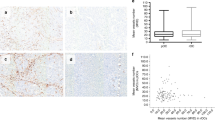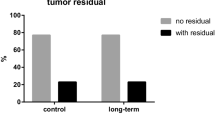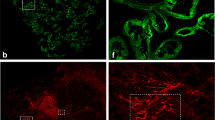Abstract
Objective
The purpose of this study was to evaluate microvessel density (MVD) as assessed by C-type lectin 14A (CLEC14A), which is a new marker for endothelial cells, and compare its expression to CD31 and CD105 in epithelial ovarian cancer (EOC).
Methods
MVD was evaluated in tumors (n = 50) from patients with EOC who underwent primary surgery and in patients with EOC who received preoperative chemotherapy (n = 49) using immunohistochemistry with antibodies to CLEC14A, CD31 and CD105. The median duration of follow-up was 24.5 months (range 1−101 months). The effect of prognostic factors on event-free survival (EFS) and overall survival (OS) was assessed using the Cox regression model.
Results
The amount of residual disease was found to be an independent prognostic factor in multivariate analysis with respect to EFS (P = 0.009) and OS (P < 0.001). The mean MVD of CLEC14A (MVD = 6), in tumors from patients who underwent primary surgery, was significantly lower than that of CD31 (MVD = 25, P < 0.0001) and CD105 (MVD = 11, P = 0.018). However, there was no significant correlation between MVD as detected by these markers and clinical outcome. There was no expression of CLEC14A in tumors from patients who received preoperative chemotherapy and the MVD of CD31 and CD105 was significantly reduced (P = 0.001 and 0.006, respectively) in this set of patients.
Conclusion
This study demonstrates MVD as detected by CLEC14A in EOC. Treatment with chemotherapy reduces tumor blood vessels significantly. We suggest that CLEC14A may be a more specific endothelial marker to assess tumor angiogenesis.



Similar content being viewed by others
References
Folkman J (1971) Tumour angiogenesis: therapeutic implications. N Engl J Med 285:1182–1186
Brekken RA, Li C, Kumar S (2002) Strategies for vascular targeting in tumours. Int J Cancer 100:123–130
Krishna Priya S, Nagare RP, Sneha VS et al (2016) Tumour angiogenesis−origin of blood vessels. Int J Cancer 139:729–735
Fox SB, Harris AL (2004) Histological quantitation of tumour angiogenesis. APMIS 112:413–430
Weidner N (1993) Tumour angiogenesis: review of current applications in tumour prognostication. Semin Diagn Pathol 10:302–313
He L, Wang Q, Zhao X (2015) Microvessel density as a prognostic factor in ovarian cancer: a systematic review and meta-analysis. Asian Pac J Cancer Prev 16:869–874
Mura M, Swain RK, Zhuang X et al (2012) Identification and angiogenic role of the novel tumour endothelial marker CLEC14A. Oncogene 31:293–305
Rho S-S, Choi H-J, Min J-K et al (2011) CLEC14A is specifically expressed in endothelial cells and mediates cell to cell adhesion. Biochem Biophys Res Commun 404:103–108
Zhuang X, Cross D, Heath VL, Bicknell R (2011) Shear stress, tip cells and regulators of endothelial migration. Biochem Soc Trans 39:1571–1575
Ki MK, Jeoung MH, Choi JR et al (2013) Human antibodies targeting the C-type lectin-like domain of the tumour endothelial cell marker CLEC14A regulate angiogenic properties in vitro. Oncogene 32:5449–5457
Zanivan S, Maione F, Hein MY et al (2013) SILAC-based proteomics of human primary endothelial cell morphogenesis unveils tumour angiogenic markers. Mol Cell Proteomics 12:3599–3611
Noy PJ, Lodhia P, Khan K et al (2015) Blocking CLEC14A-MMRN2 binding inhibits sprouting angiogenesis and tumour growth. Oncogene. 34(47):5821–5831
Horak ER, Leek R, Klenk N et al (1992) Angiogenesis, assessed by platelet/endothelial cell adhesion molecule antibodies, as indicator of node metastases and survival in breast cancer. Lancet 340:1120–1124
Parums DV, Cordell JL, Micklem K et al (1990) JC70: a new monoclonal antibody that detects vascular endothelium associated antigen on routinely processed tissue sections. J Clin Pathol 43:752–757
Haruta Y, Seon BK (1986) Distinct human leukemia-associated cell surface glycoprotein GP160 defined by monoclonal antibody SN6. Proc Natl Acad Sci USA 83:7898–7902
Nassiri F, Cusimano MD, Scheithauer BW et al (2011) Endoglin (CD105): a review of its role in angiogenesis and tumour diagnosis, progression and therapy. Anticancer Res 31:2283–2290
Li DY, Sorensen LK, Brooke BS et al (1999) Defective angiogenesis in mice lacking endoglin. Science 284:1534–1537
Rosen LS, Hurwitz HI, Wong MK et al (2012) A phase I first-in-human study of TRC105 (anti-endoglin antibody) in patients with advanced cancer. Clin Cancer Res 18:4820–4829
Karzai FH, Apolo AB, Cao L et al (2014) A phase I study of TRC105 anti-CD105 (endoglin) antibody in metastatic castration-resistant prostate cancer. BJU Int 116(4):546–555
Gordon MS, Robert F, Matei D et al (2014) An open-label phase Ib dose-escalation study of trc105 (anti-endoglin antibody) with bevacizumab in patients with advanced cancer. Clin Cancer Res 20:5918–5926
Costello B, Li C, Duff S et al (2004) Perfusion of 99Tcm-labeled CD105 Mab into kidneys from patients with renal carcinoma suggests that CD105 is a promising vascular target. Int J Cancer 109:436–441
Steg AD, Bevis KS, Katre AA et al (2012) Stem cell pathways contribute to clinical chemoresistance in ovarian cancer. Clin Cancer Res 18:869–881
Cox DR, Oakes D (1984) Analysis of Survival Data. Chapman and Hall, New York
Kaplan EL, Meier P (1958) Nonparametric estimation from incomplete observations. J Am Stat Assoc 53:457
Taskiran C, Erdem O, Onan A et al (2006) The prognostic value of endoglin (CD105) expression in ovarian carcinoma. Int J Gynecol Cancer 16:1789–1793
Rubatt JM, Darcy KM, Hutson A et al (2009) Independent prognostic relevance of microvessel density in advanced epithelial ovarian cancer and associations between CD31, CD105, p53 status, and angiogenic marker expression: a Gynecologic Oncology Group study. Gynecol Oncol 112:469–474
Saad RS, Liu YL, Nathan G et al (2004) Endoglin (CD105) and vascular endothelial growth factor as prognostic markers in colorectal cancer. Mod Pathol 17:197–203
El-Gohary YM, Silverman JF, Olson PR et al (2007) Endoglin (CD105) and vascular endothelial growth factor as prognostic markers in prostatic adenocarcinoma. Am J Clin Pathol 127:572–579
Miyata Y, Sagara Y, Watanabe S et al (2013) CD105 is a more appropriate marker for evaluating angiogenesis in urothelial cancer of the upper urinary tract than CD31 or CD34. Virchows Arch Int J Pathol 463:673–679
Dales J-P, Garcia S, Bonnier P et al (2003) CD105 expression is a marker of high metastatic risk and poor outcome in breast carcinomas. Correlations between immunohistochemical analysis and long-term follow-up in a series of 929 patients. Am J Clin Pathol 119:374–380
Rau K-M, Huang C-C, Chiu T-J et al (2012) Neovascularization evaluated by CD105 correlates well with prognostic factors in breast cancers. Exp Ther Med 4:231–236
Sundar SS, Zhang H, Brown P et al (2006) Role of lymphangiogenesis in epithelial ovarian cancer. Br J Cancer 94:1650–1657
Cwiklnska A, Sobstyl M, Kwasniewski W, Bednarek W (2013) Microtissue density prognostic factor evaluation based on antigens CD34 and CD 105 in ovarian cancer patients. Ann Agric Environ Med 20:838–842
Bock AJ, Tuft Stavnes H, Kærn J et al (2011) Endoglin (CD105) expression in ovarian serous carcinoma effusions is related to chemotherapy status. Tumour Biol 32:589–596
Orre M, Lotfi-Miri M, Mamers P, Rogers PA (1998) Increased microvessel density in mucinous compared with malignant serous and benign tumours of the ovary. Br J Cancer 77:2204–2209
Cerami E, Gao J, Dogrusoz U et al (2012) The cBio cancer genomics portal: an open platform for exploring multidimensional cancer genomics data. Cancer Discov 2:401–404
Gao J, Aksoy BA, Dogrusoz U et al (2013) Integrative analysis of complex cancer genomics and clinical profiles using the cBioPortal. Sci Signal 6:pl1
Beresford MJ, Harris AL, Ah-See M et al (2006) The relationship of the neo-angiogenic marker, endoglin, with response to neoadjuvant chemotherapy in breast cancer. Br J Cancer 95:1683–1688
Hollingsworth HC, Kohn EC, Steinberg SM et al (1995) Tumour angiogenesis in advanced stage ovarian carcinoma. Am J Pathol 147:33–41
Alvarez AA, Krigman HR, Whitaker RS et al (1999) The prognostic significance of angiogenesis in epithelial ovarian carcinoma. Clin Cancer Res 5:587–591
Abulafia O, Ruiz JE, Holcomb K et al (2000) Angiogenesis in early-invasive and low-malignant-potential epithelial ovarian carcinoma. Obstet Gynecol 95:548–552
Huynh H, Teo CCM, Soo KC (2007) Bevacizumab and rapamycin inhibit tumour growth in peritoneal model of human ovarian cancer. Mol Cancer Ther 6:2959–2966
Perren TJ, Swart AM, Pfisterer J et al (2011) A phase 3 trial of bevacizumab in ovarian cancer. N Engl J Med 365:2484–2496
Burger RA, Brady MF, Bookman MA et al (2011) Incorporation of bevacizumab in the primary treatment of ovarian cancer. N Engl J Med 365:2473–2483
Acknowledgments
We thank the Board of Research in Nuclear Sciences (BRNS) and the Department of Biotechnology, Government of India for the funding. We are grateful to the faculty and technical staff in the department of histopathology, Amrita Institute of Medical Sciences (AIMS) for their help. We thank Dr. S. Shirley and Dr. Kanchan Murhekar, Cancer Institute (WIA) for their timely suggestions. We acknowledge the assistance of Dr. K. R. Sundaram and Ms. Amrutha Jose, Department of Biostatistics, AIMS, Cochin and Dr. Swaminathan and Dr. Rama, Tumour Registry, Cancer Institute (WIA), Chennai for statistical analysis.
Author information
Authors and Affiliations
Corresponding author
Ethics declarations
Conflict of interest
The authors declare that they have no conflict of interest.
Funding
This study was funded by the Board of Research in Nuclear Sciences and Department of Biotechnology, Government of India. Ms.S.Krishna Priya and Mr.Rohit P Nagare are recipients of a Senior Research Fellowship from the Indian Council for Medical Research (ICMR), Government of India.
Electronic supplementary material
Below is the link to the electronic supplementary material.
About this article
Cite this article
Krishna Priya, S., Kumar, K., Hiran, K.R. et al. Expression of a novel endothelial marker, C-type lectin 14A, in epithelial ovarian cancer and its prognostic significance. Int J Clin Oncol 22, 107–117 (2017). https://doi.org/10.1007/s10147-016-1033-6
Received:
Accepted:
Published:
Issue Date:
DOI: https://doi.org/10.1007/s10147-016-1033-6




